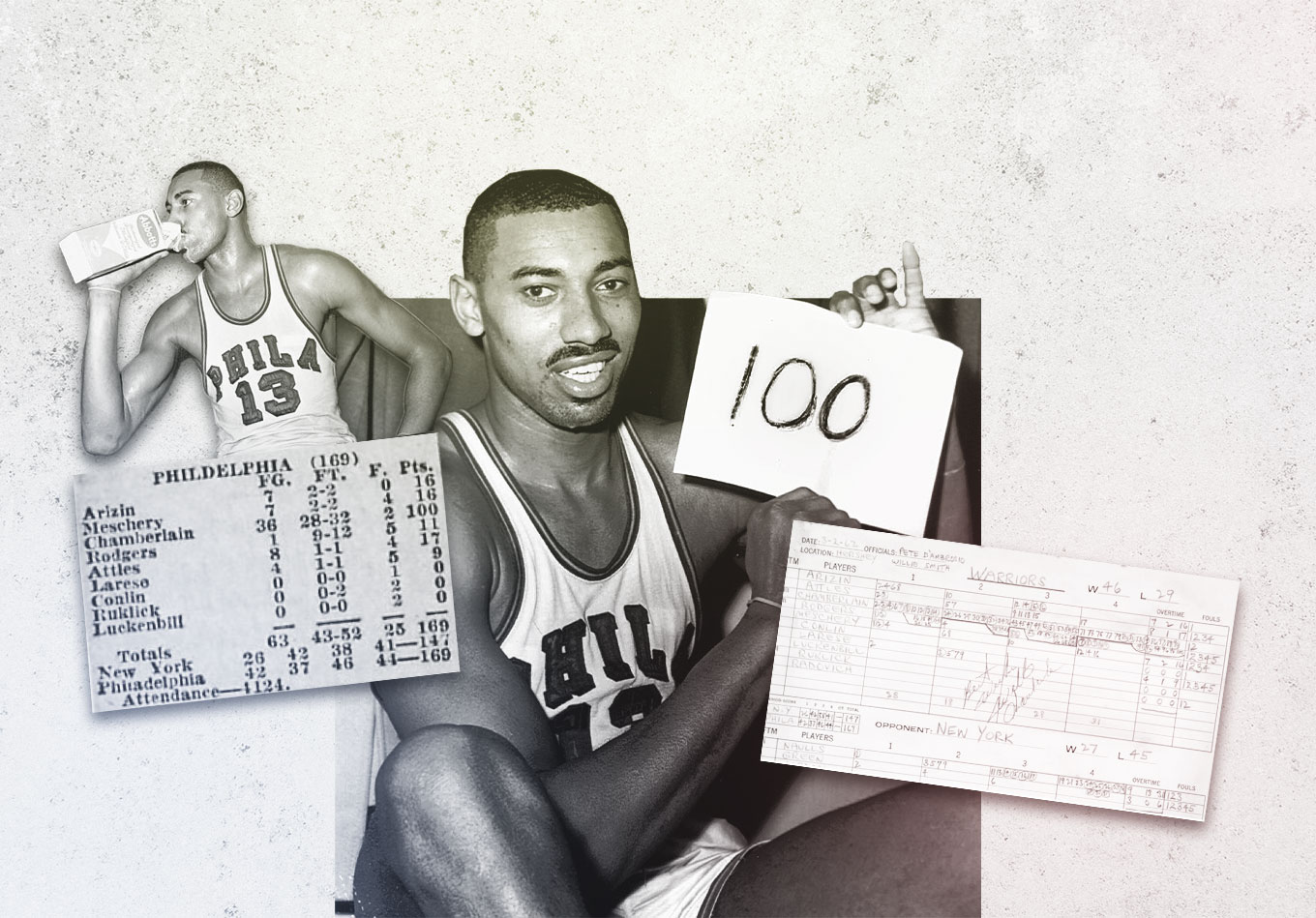Sixty years ago, Wilt Chamberlain of the Philadelphia Warriors scored 100 points in a regular-season game against the New York Knicks, the greatest single-game record in the history of not just the NBA, but in any of the major professional sports leagues in North America.
As former NFL coach Bill Parcells would say, “And it’s not close for second.” This is the story of that stunning achievement.
Hershey, Pennsylvania is a community of about 15,000 people, squeezed into the eastern part of the state, some 100 miles west of Philadelphia and 15 miles east of Harrisburg – the state capital. To some, it’s still regarded as the Chocolate Capital of the World (though Brussels and Switzerland would like a word). It’s the home to Hersheypark, an expansive theme attraction that features more roller coasters than you have fingers and more water rides than you have toes. And if you like sports, there’s the Hershey Bears hockey team, playing continuously in the American Hockey League since 1938.
Hershey is close enough to Philadelphia that in the sleepy early years of the NBA, the Warriors, one of the original franchises in the league that began as the Basketball Association of America in 1946, occasionally played regular-season games at what was known as the Hershey Sports Arena, then the home of the Bears hockey team.
Indeed, in each of the Warriors’ last four seasons representing The City Of Brotherly Love before moving to San Francisco, there were multiple Warriors games played at the “neutral site” of Hershey. There was even an established regularity of sorts to those visits – one during the week after Christmas, and one on the first Friday of March. (Such regularity was enabled by the fact that in those years, the NBA schedule was constructed by none other than Warriors owner Eddie Gottlieb, who was born in 1898 in Kyiv.)
And so it happened that on Friday, March 2, 1962, the Warriors made what turned out to be their final visit to Hershey. In fact, it turned out to be the last regular-season game that the Philadelphia Warriors played in the state of Pennsylvania. It was No. 76 of an 80-game season; the team would finish that season playing its last four regular-season games on the road. (Hershey had a brief resurgence as a host to NBA games in the early 70s, when the 76ers played a few games there for three seasons. The Syracuse Nationals franchise had moved to Philadelphia in 1963, adopting a new team name, to fill the void left by the Warriors’ move west.)
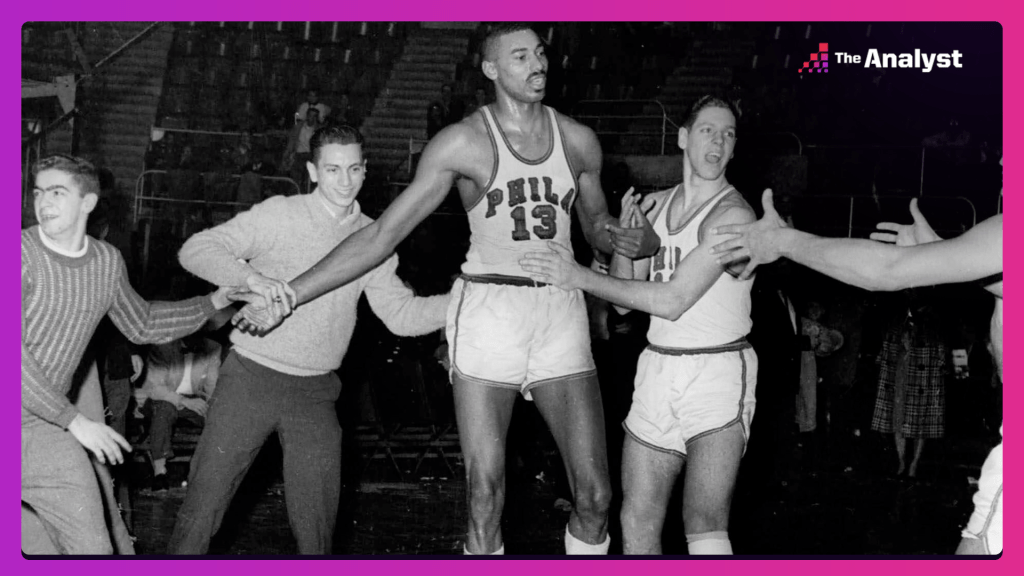
The Warriors were led in that 1961-62 season by Chamberlain, then in his third season in the NBA. The native Philadelphian had starred at Overbrook High School, and Gottlieb secured his rights through the league’s “territorial draft” rule that gave teams the right to draft a player who had starred locally in high school or college.
At 7-foot-1, Wilt had electrified the league like no player before or since when he arrived after having played at the University of Kansas and one year with the Harlem Globetrotters. No athlete in a team sport has ever brought the package of size, strength and speed into a league that the young Chamberlain delivered to the NBA in 1959.
Yes, speed. It’s a shame that most of the surviving video of Wilt playing in the NBA comes from the late stages of his career with the Lakers. At that point, he relied mostly on strength and smarts, but his play appears slow, flat-footed and mechanical. The young Wilt was a top-rate athlete in every sense of the word and had the ability to run the floor on the break as if he were a foot shorter.
Chamberlain set NBA single-season scoring records of 2,707 points and 37.6 points per game as a rookie, and then surpassed each mark in his second season (3,033 points, 38.4 per game) after the NBA had expanded its schedule from 72 to 79 games. (After one season at 79, the schedule would tick up to 80 games.)
Despite those astounding totals, however, and in a sign of things to come, Wilt’s Warriors failed to reach the NBA Finals, losing to Bill Russell’s Boston Celtics in the 1960 Eastern finals and then falling to Syracuse the next year. (Over their careers, Chamberlain’s teams would oppose Russell’s Celtics in eight playoff series – all best of sevens in either the Eastern finals or the NBA Finals. Boston won seven of those eight series, four of which extended to a seventh game. Among those Game 7 losses that Wilt’s teams endured, two came by the margin of two points and one by a margin of a single point.)
After that disappointment, the Warriors changed their coach. (The term “head coach” was not yet necessary; with the Warriors, like most other NBA teams in an era of frugality, there were no assistant coaches.) Gottlieb replaced former Warriors player Neil Johnston with Frank McGuire, a successful college coach at St. John’s and North Carolina, and whose Tar Heels had nipped Chamberlain’s Jayhawks 54-53 in a triple-overtime championship game of the 1957 NCAA Tournament.
McGuire and Chamberlain hit it off, with the new coach intent on getting the absolute maximum out of his all-too-willing star. (Alvin Attles, a starting guard on that Warriors team, later said that he learned that Wilt and McGuire had made a “pact” that Wilt would average 50 points that season.) Not content with the production that Wilt had achieved under Johnston, McGuire determined to increase it, starting with playing time.
But wait…Hadn’t Wilt averaged 46.4 and 47.8 minutes over his first two seasons? True, but that was still not enough. As hard as this is to believe, during the 80-game 1961-62 season (and in the team’s 12 playoff games) in which Wilt started every game, McGuire never removed him from the court. You read that correctly. Wilt played every minute in 79 of the Warriors’ 80 games, failing to complete only the Jan. 3 game at Los Angeles, when referee Norm Drucker removed Wilt from the floor by ejecting him with 8:33 left in the game.
That season, Wilt played every moment of games that Philadelphia won by final margins of 32, 37 and 43 points, just as he played every moment of games that his team lost by margins of 25, 41 and 51 points. Factoring in overtime games, Wilt played 48.5 minutes per game that season.
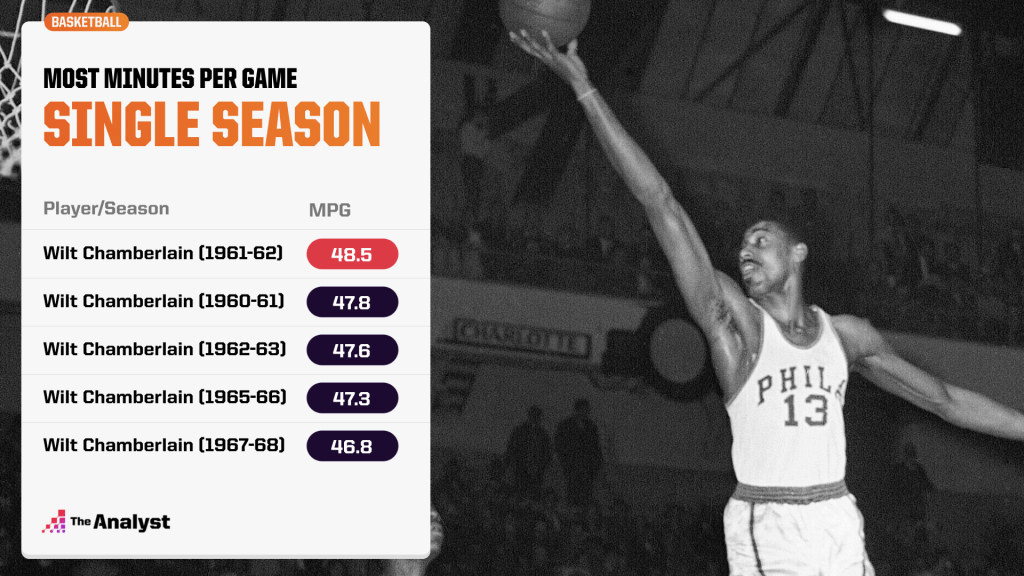
Today’s NBA schedule is often described as grueling. In the current 2021-22 season, each team plays 82 games over a period of 174 days, extending from Oct. 19 to April 10. Sixty seasons ago, when each team played 80 games, the schedule also began on Oct. 19. But it concluded on March 14, meaning that those 80 games were crammed into 147 days! Think about that: Picture the hurly-burly of today’s NBA schedule, take away two games, and compress it into 27 fewer days. Now factor in the difference between the early 1960s and today in terms of air travel, comfort, and health and safety issues.
The 1961-62 Warriors played eight sequences of three games in three nights, had two other sequences of four in four nights, and another of five in five nights. The five-in-five-nights streak came in the middle of January: a Wednesday game against the St. Louis Hawks played as part of an all-NBA doubleheader in Detroit, back home on Thursday to host the Cincinnati Royals, a Friday night contest against the Detroit Pistons in Boston (part of another doubleheader), back home to meet the Pistons again on Saturday, and then a Sunday game against the Syracuse Nationals played in Utica, N.Y. (The Warriors went 4-1 over that stretch, with two of the games going into overtime. Wilt’s tally in those games? He scored 62, 54, 53, 44 and 62 points. A total of 275 points over 250 minutes, spread over five consecutive nights encompassing four nights of travel. Now that’s grueling.)
To say that literally every Warriors possession ran through Wilt would be an overstatement, but not a major one. In that era, the NBA ranked its individual scoring leaders on the basis of total points, rather than points per game. Wilt had been the first NBA player to reach the 2,500-point mark, doing it as a rookie. In his second season, he became the league’s first 3,000-point scorer. Now, he set his sights even higher. In the fall of 1961, he scored 496 points over his first 10 games of the season, exceeding 50 points in six of those games.
Playing all 63 minutes (of course) in a triple-overtime loss to the Lakers on Dec. 8, Wilt produced an NBA single-game record of 78 points, breaking the mark of 71 points established by the Lakers’ Elgin Baylor 13 months earlier. (By the way, Baylor scored 63 and teammate Jerry West 32 in that triple-overtime game, while none of Wilt’s teammates scored as many as 20.) On Jan. 13 against the Chicago Packers, a first-year expansion team that would eventually answer to the name of Washington Wizards, Wilt poured in 73 points, breaking Baylor’s record for a regulation-length game.
By the end of that month, the math had worked out to near perfection: With 70% of the season played, 56 games down and 24 to go, Wilt had scored 2,801 points – an average of 50.018 points per game and on pace for a 4,000-point season.
Chamberlain held serve during February – 19 games, 962 points, 50.6 per game. Entering March, he needed 237 points over the season’s last five games to concurrently reach 4,000 for the season and achieve a 50-point average. But those five remaining games did contain one potential problem: game No. 78, on March 7 at Boston. Led by superstar center Bill Russell, the Celtics had always been Wilt’s toughest opponent. Even in this season of 50-point nights, Chamberlain wound up averaging a mere 41.7 points in 12 games against the Celtics, compared with 51.9 per game against the rest of the league. In addition, Wilt had been held below 30 points in just two games all season, both against the Celtics (28 on Nov. 3, and 26 in their most recent meeting, on Feb. 24). To reach 4,000 points, Wilt might need as much of a pad as he could muster with that Celtics game looming.
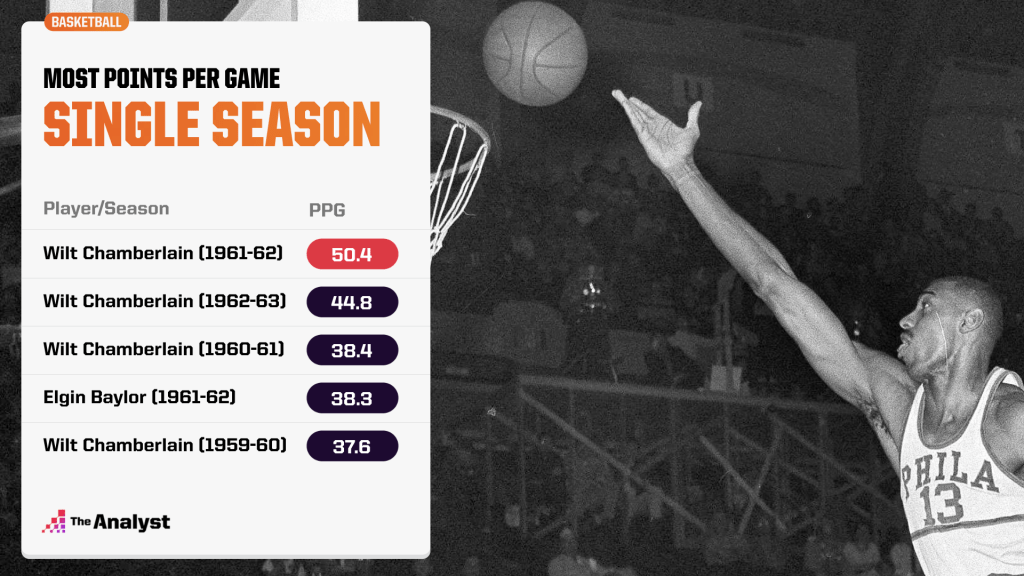
All of this came to a head on March 2 in Hershey. That night’s opponents: the lowly New York Knicks, playing out the string en route to a 29-51 season. The Knicks actually had some good players, notably guard Richie Guerin and forward Willie Naulls, but they did not have a strong center. In addition, their usual starter at the position, veteran Phil Jordon, was ill and unable to even make the game. His backup was Darrall Imhoff, listed at 6-10 and 220 pounds, but in no way a physical match for Chamberlain. So we had a determined superstar aiming at a 4,000-point season, a coach who encouraged that process, and a weak opponent further diminished by the absence of its regular center. The stage was set.
The Warriors held a 42-26 lead after the first quarter, and Chamberlain had gotten off to an impressive start. Over those 12 minutes he scored 23 points, including 9-of-9 shooting from the foul line. Wilt was a terrible free-throw shooter who finished his 14-year career having hit just 51.1% from the line. But he was a bit better than that during the 1961-62 season after adopting a McGuire suggestion to shoot his free throws underhanded, as a handful of NBA players still did. Wilt made 61.3% of his free throws that season, the only one of his 14 seasons in which he reached 60%.
Imhoff, meanwhile, finished the opening quarter with three personal fouls. Knicks coach Eddie Donovan showed him a seat on the bench, and in his place came rookie Cleveland Buckner, listed at 6-9 and 210 pounds, and even a less physical presence than Imhoff. In one respect, the game mirrored the teams’ last meeting five days earlier in Philadelphia when Jordon was ejected early in the third quarter and Imhoff, his replacement, fouled out later in that quarter. Buckner was the next man up, but New York held a 19-point lead entering the final quarter. Chamberlain had an NBA-record 28 points in that quarter, but the Knicks prevailed 149-135.
The crowd of 4,124 fans in Hershey saw Wilt continue to pile up the points in the second quarter. It was only in retrospect, after the 100-point game was in the books, that it could be said that Wilt added “only” 18 points in the second quarter. At halftime, the score stood Warriors 79, Knicks 68, Wilt 41. He had hit 14 of 26 shots from the floor, and, remarkably, 13 of 14 from the foul line.
In the third quarter, as the Warriors began pulling away, Wilt drew closer and closer to his own NBA single-game record of 78 points. During that period, The Big Dipper hit 10 of 16 from the floor and an absolutely astounding 8 of 8 on free throws. His total of 28 points in a quarter tied the record he had set against the Knicks five days earlier. That gave him 69 points with 12 minutes to go. History beckoned.
Of course, Wilt wasn’t exactly scoring all those points by himself. Throughout the game, teammates intrigued by the circumstances talked openly about feeding “the big guy” even more than usual to see how many points he could amass. The result of the game meant nothing in the standings. Philadelphia was locked into a second-place finish to Boston in the four-team Eastern Division, while the Knicks would finish last.
The Warriors took a 19-point lead into the fourth quarter, but by then, every fan was focused on how high Wilt would go. There were no high-tech scoreboards with visual displays of Wilt’s totals, but Warriors public-address announcer Dave Zinkoff, whose booming voice would keep fans from dozing off for decades, had made the trip west from Philadelphia to Hershey. In the old, cold barn that was the Hershey Sports Arena, Zinkoff now thundered out Chamberlain’s running point total with every basket and free throw made.
Neither team televised the game, which was not unusual for the NBA in the early 1960s. It was broadcast on radio over Philadelphia station WCAU, with Bill Campbell on the call. Some years back, a recording of the fourth quarter of the game emerged on the internet. Campbell’s dramatic call still lives on YouTube and a listener can clearly hear Zink’s pronouncements to the crowd.
In the fourth quarter, NBA records were tied and surpassed in a dizzying parade of numbers. First, just 95 seconds in, The Big Fella tied his own mark of 73 points in a regulation-length game. Within moments he passed that mark, and then became the first player ever to reach 80. Blink, and he was up to 90.
The Knicks, recognizing what was going on, were increasingly ticked off. By the fourth quarter, they tried to stall on offense; the Warriors responded by fouling them to stop the clock and get the ball back for Wilt. Somewhere along the way, WCAU’s Campbell advised his audience to call their friends to alert them to history in the making. At the end, Wilt was on the floor with Guy Rodgers, an outstanding point guard who was, like Wilt, a native Philadelphian, and is now enshrined in the Basketball Hall of Fame. Along with them were three players from the deep end of the bench – rookies Ted Luckenbill and York Larese, and Wilt’s nominal backup, Joe Ruklick.
With just under two minutes left, Wilt had reached 96. The Knicks had the ball and Luckenbill fouled Naulls, who made two foul shots. Wilt then reached 98 on a dunk off a pass from Larese, stole the in-bounds pass himself, and missed on his first attempt at 100. New York rebounded and passed the ball around until with 61 seconds left, Guerin, the Knicks star who was an ex-Marine and by now was fed up, was fouled by Luckenbill and then got into a yelling match with Ruklick. After Guerin’s free throws, the Warriors got the ball back, and we’ll let Campbell take it from here:
(via carlzson299)
“Now let’s see if they foul somebody quick. Rodgers throws long to Chamberlain. He’s got it, he’s trying to get up, he shoots. No good. Rebound, Luckenbill. Back to Chamberlain. Shoots, up, no good, in and out. The rebound, Luckenbill. Back to Ruklick. In to Chamberlain. He made it! He made it! He made it! A Dipper dunk! He made it! The fans are all over the floor! They’ve stopped the game! People are running out onto the court. One hundred points for Wilt Chamberlain.”
Wilt’s final basket came with 46 seconds left. The floor was cleared, the Knicks added a field goal and two free throws, and it was over. The Warriors’ victory went into the books with a score of 169-147, setting a record at the time for the most combined points in an NBA game. But as Campbell went off the air, he gave the final score as 169-150. To this day, it’s unclear which Knicks total is accurate.
That the game was played in a small arena in a small community, at a time when an NBA game was a far less lustrous attraction than today, that it was not televised, that there is confusion about the final score, and that there exists an ongoing debate over what happened to the game ball – all of that adds to the cloak of mystery and legend. No video of the game has ever emerged. There are some still photographs of Wilt in action primarily shot by Associated Press photographer Paul Vathis, who also took the iconic post-game photo of Wilt in the locker room, holding up a piece of paper with “100” written on it.
What is known is that Wilt scored 100 points, making 36 of 63 field-goal attempts and 28 of 32 free-throw attempts. He set NBA records for points in a game, a half and a quarter, as well as subordinate records for field goals, field-goal attempts and, yes, free throws made. (The record for points in a quarter now belongs to Klay Thompson, who had 37 in a quarter in 2015. The record for free throws made was tied by Adrian Dantley in 1984.)
No player has ever seriously threatened Wilt’s exclusive membership in the 100 Points In A Game Club. There have been only 10 other games in NBA history in which a player reached 70 points. Wilt had five of those games (his 78- and 73-point games earlier in the 1961-62 season, and games of 73, 72 and 70 points the following season. The others were produced by Baylor (71 in 1960), David Thompson (73 in 1978), David Robinson (71 in 1994), Kobe Bryant (81 in 2006) and Devin Booker (70 in 2017).
Of course, the NBA introduced the 3-point field goal in 1979. Robinson made one in his big game; Bryant hit seven and Booker four in theirs.
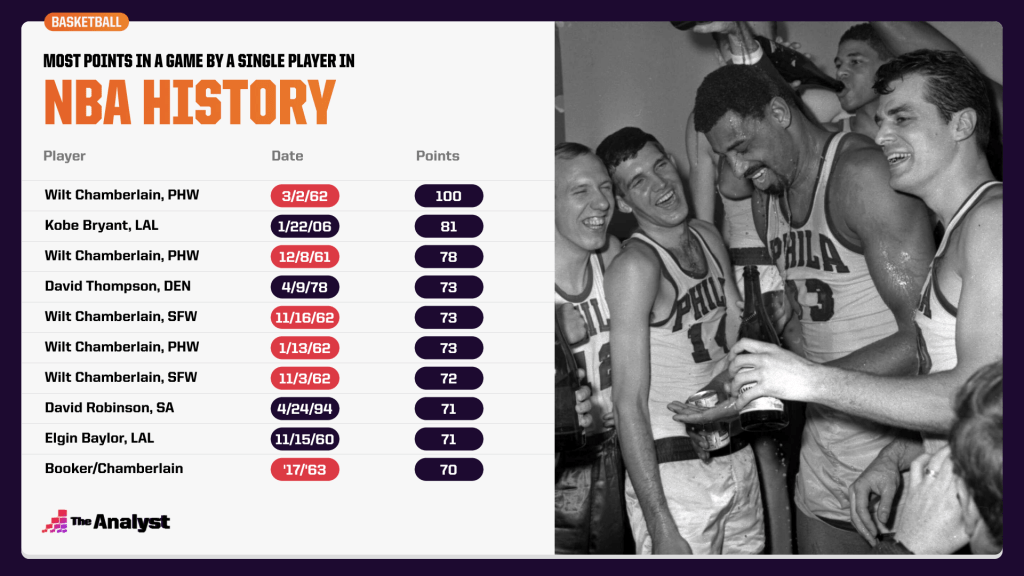
Wilt played 11 more seasons in the NBA, 14 in all. He played for the Warriors in Philadelphia and San Francisco, before, in January 1965, he was traded back to Philadelphia, where the transplanted Syracuse team had become the 76ers. Then he was dealt again, to the Los Angeles Lakers, in the summer of 1968, finishing his career with five seasons there. His resume includes two championships (1967 with the 76ers, 1972 with the Lakers), 13 All-Star selections (all but the 1969-70 season, which he missed nearly entirely due to a severe knee injury), four regular-season MVP awards, one Finals MVP, and one All-Star Game MVP.
He led the league in scoring seven times (each of his first seven seasons), in shooting accuracy nine times, in rebounding 11 times, and in assists once (the only center in NBA history to do so). He led in minutes played eight times, but appeared in 1,045 regular-season games and 160 in the playoffs without ever fouling out. Of course, he was a first-ballot Hall of Famer. His No. 13 was retired by each of the three franchises for which he played.
And yet, there was a sadness. Nothing he did ever seemed good enough. It was said that it’s easy to root against Golaith, but it was more than that. Wilt’s greatest accomplishments, even his 100-point game, were blithely dismissed by his critics as being the product of his height – and that alone.
Certainly his height was a factor in his success, but more remarkable was the breadth of athleticism contained therein, and perhaps more critically, the will to put that athleticism to extreme tests. He was a Superman walking among us, who did things no one before him or since has done. And the world shrugged.
That is, until Oct. 12, 1999, when the news came that Wilt had died at age 63. Death is the most ordinary of things that comes to every man, but the death of this Superman was what ultimately shocked us all.
Enjoy this? Subscribe to our mailing list to receive exclusive weekly content.
Design by Matt Sisneros.
